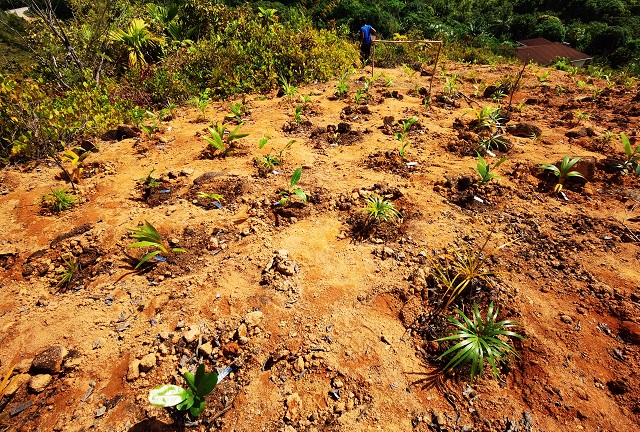Many opportunities exist for business, leisure, eco-tourism, education, and research at Pasquière on Praslin Island now that three hectares of wetland and two hectares of once-degraded foothill have been rehabilitated.
This is a result of a three-year project undertaken by a Praslin-based not-for-profit organisation, the Terrestrial Restoration Action Society Seychelles (TRASS), under a project funded by the Western Indian Ocean Strategic Action Programme (WIOSAP) of the Nairobi Convention and the United Nations Environment Programme (UNEP).
In addition to the rehabilitation work, the organisation now has rehabilitation and management plans for the second most populated island after collecting data on baseline environmental conditions of the marsh, mangrove, degraded shrubland, and bare hills above wetlands on Praslin.
Since June 2020, TRASS has also been able to propagate over 3,500 seedlings, a long-term programme for the monitoring of the site established. In addition, 10 Seychellois volunteers have acquired new knowledge and capacity in habitat rehabilitation techniques and monitoring.
Three hectares of wetland and two hectares of once-degraded foothill have been rehabilitated. (TRASS) Photo License: CC-BY
Recently, a representative of WIOSAP was in Seychelles recently to evaluate the impact of the work TRASS undertook under the project. Jared Bosire visited different sites where there has been rehabilitation, as well as the nursery where these plants were produced.
“My expectations have been exceeded. I have been in programme management for a long time at different levels. Thank you for the excellent work. Another aspect is the innovation I see in the project, trying new things that have not been tried, and seeing whether they work. Many of us fear to fail, but we would not have succeeded if we had not tried,” said Bosire at a presentation of the project, which will close in June this year.
Elvina Henriette, programme manager at TRASS, said that the organsation is very proud of the achievements and accomplishments under this project, something that could not be done without the dedication of a small group of volunteers, including schoolchildren and different organisations, both private and public.
The group of volunteers included schoolchildren. (TRASS) Photo License: CC-BY
Pasquière, located at Baie Ste Anne, now presents the local community with the opportunity for a wide range of activities. Henriette added that the work done at Pasquière is one of TRASS’s main accomplishments.
“The rehabilitation of Pasquière coastal wetland, forest, and the adjacent degraded hill will provide opportunities to build a nature trail to explore the rehabilitated area considering that it hosts some interesting natural features. This will necessitate the upgrading of the existing walking trail around the wetland, across the river, and uphill to the rehabilitated areas as part of a ‘nature experience tour,” explained Henriette.
Henriette added this includes boardwalks and weatherproof benches that could be placed in the area to enhance the visitor’s experience.
“Clients can enjoy the scenic, and aesthetic beauty of the place as well as bird hides for bird watching could be envisaged. Signboards and information boards can be placed in strategic areas along the trail. Considering that there are several tourism establishments in the vicinity, tour guides could benefit from some extra income through the setup of an extra business,” added the conservation biologist.
The attractions of Pasquière, such as La Plaine Hollandaise, the Salazie trail, and the Curieuse Marine National Park, may be used by hotels and other businesses to attract clients to their establishments.
“For instance, some operators already use the presence of the marine park, Curieuse, Vallée de Mai, and other parks to attract clients and keep them on Praslin. Hence clients can increase their length of stay and spend more, thus benefiting different sectors,” she said
The area showcases biodiversity as well as friendly alternative livelihoods and sustainable forestry, perfect for research and education. There are also several natural beehives that were found during the rehabilitation.
TRASS and its sister organisation, Gaea Seychelles, had always intended to integrate beekeeping into restoration efforts because bees need plants for their survival, and plants on restoration sites need to be pollinated by the bees for their persistence and proliferation, according to Henriette.
She said that there is the opportunity to install some beehives on the site for beekeeping, which apart from assisting in the restoration efforts, will also provide an alternative income for beekeepers and could also be integrated into the nature trail experience.

